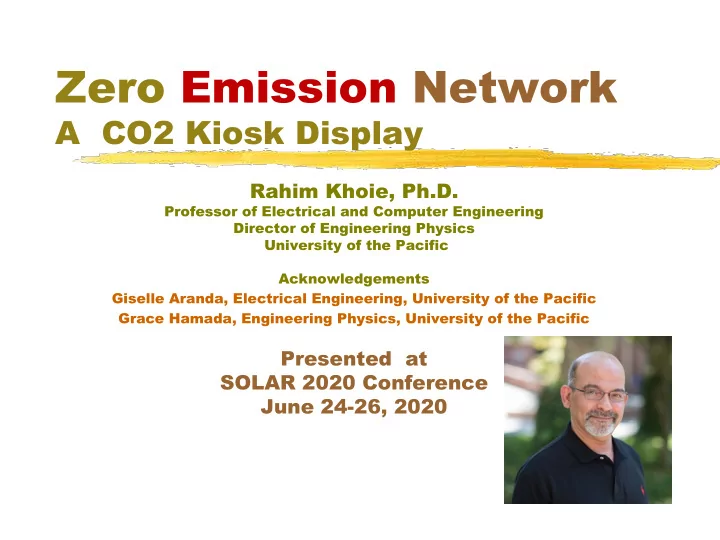

Zero Emission Network A CO2 Kiosk Display Rahim Khoie, Ph.D. Professor of Electrical and Computer Engineering Director of Engineering Physics University of the Pacific Acknowledgements Giselle Aranda, Electrical Engineering, University of the Pacific Grace Hamada, Engineering Physics, University of the Pacific Presented at SOLAR 2020 Conference June 24-26, 2020
In 2018, U.S. Emissions 2
CO2 Kiosk Specification Ø Design and build a Carbon Dioxide Kiosk that displays the local, national, and global levels of carbon dioxide in the atmosphere. Ø The requirements of the system are: Ø solar powered, Ø updating data once every 24 hours, Ø measure and display carbon dioxide content of the local atmosphere in part per million, Ø be visible from 100 yards, and Ø acquire and display the national and global CO2 data from reliable sources, and particularly from the U.S. Energy Information Agency websites (U.S. EIA): https://www.eia.gov/environment/emissions/carbon/. 3
System’s Behavior 4
Functional Design 5
The main components of the system The CO2 sensor module which uses a light tube consisting of an infrared source Ø and an infrared sensor used for detection of the CO2 content in the air at the locale. A low pass filter is used to reduce the interference noise. The signal from the sensor is further amplified and is received by the microcontroller for processing and storage. The microcontroller module which receives, processes, and displays the data. Ø The display module that is powered from a DC source and is controlled by the Ø microcontroller. This module consists of three display panels for local, national, and global CO2 data. The power module which consists of a solar panel, a rechargeable battery, and Ø voltage regulator at various DC levels for the microcontroller module and the display module. The wi-fi module which is used to access websites for data on national and global Ø CO2 data. The software module which consists of required programs to run the Ø microcontroller and the wi-fi modules. 6
Closing Ø It’s time to remove carbon! Ø It’s time to go to people! Ø It’s time to plant trees! 7
Afterword: 100 Years From Now … What Would They Say About US? Ø … That we burnt anything that we could burn… Ø …Or that we genuinely cared about the environment … 8
Additional Information Ø Do you have a mock up images of what that would look like? Ø Cost? Ø Timeline when it would be developed? Ø Where you would install it ? Ø What would be the most challenging in making such a device and such? 9
Kiosk LX Model $7,000 Boulder 410 ppm https://www.allendisplay.com/Touch-Screen-43-Floor-Standing-Digital-Kiosk-Display-w- BrightSign-Media- U.S. 413 ppm Earth 415 ppm 10
Kiosk Boulder SE Model 410 ppm $3,000 https://www.cdw.com/product/Philips-Signage-Solutions-Q-Line-BDL4830QL-Q-Line- U.S. 413 ppm Earth 415 ppm 11
Electronics Dollar Budget Power Source Part Dealer Quantity Price Voltage Regulator Digi-Key 1 $0.87 DC/DC Converter TRC Electronics 1 $20.40 PV Panels Toboa 1 $42.35 Battery Battery Sharks 1 $18.50 Total $82.12 12
Electronics Dollar Budget Microcontroller and Display Part Qty. Price(USD) SCD30 Sensor 1 $57.50 ACR-IoT board 1 $29.00 DC-DC converter 1 $10.00 LCD display 1 $84.95 Total: $181.45 13
Timeline? Ø By December 2020, Grace and Giselle will finish a working prototype of the electronics system. Ø We will install it on University of the Pacific campus. Ø It will be STUDENT VERSION of the device. Ø Manufacturing for Boulder and Beyond? 14
Interested in Some Interesting Facts? Ø U.S. has 20,000 cities! Ø 8,000 of U.S. Cities are with 100 miles of ocean! Ø 120 million Americans live within 100 miles of ocean! Ø There are 100 million homes in the U.S. ! Ø 40 million of these homes are within 100 miles of the ocean! Ø Average price of homes in the U.S. is $250,000 Ø Severe costal flooding will cost $10 trillion. Ø Installing a $5,000 Kiosk in 20,000 cities will cost $100 million! Ø Ratio: $100 M/$10 T is 1/100,000 ! Ø Return on Investment: 100,000 times ! 15
A Student of Mine Wrote: Don’t Do Do Anything Something Loss: Global Loss: Warming Not 0 - $1 B Happening Global Prevent Loss: Coastal Warming - $10 T Flooding, Happening Displace ……. 120 million 16
The Massive Coastal Flooding Caused by Global Warming 17
Recommend
More recommend